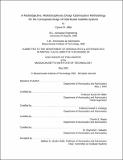| dc.contributor.advisor | David W. Miller. | en_US |
| dc.contributor.author | Jilla, Cyrus D., 1974- | en_US |
| dc.contributor.other | Massachusetts Institute of Technology. Dept. of Aeronautics and Astronautics. | en_US |
| dc.date.accessioned | 2005-05-19T14:58:25Z | |
| dc.date.available | 2005-05-19T14:58:25Z | |
| dc.date.copyright | 2002 | en_US |
| dc.date.issued | 2002 | en_US |
| dc.identifier.uri | http://hdl.handle.net/1721.1/16837 | |
| dc.description | Thesis (Ph. D.)--Massachusetts Institute of Technology, Dept. of Aeronautics and Astronautics, 2002. | en_US |
| dc.description | Includes bibliographical references (p. 427-438). | en_US |
| dc.description | This electronic version was submitted by the student author. The certified thesis is available in the Institute Archives and Special Collections. | en_US |
| dc.description.abstract | A multiobjective, multidisciplinary design optimization methodology for mathematically modeling the distributed satellite system (DSS) conceptual design problem as an optimization problem has been developed to advance the state-of-the-art in complex distributed satellite network design. An increasing number of space missions are utilizing DSS architectures in which multiple satellites work in a coordinated fashion to improve system performance, cost, and survivability. The trade space for distributed satellite systems can be enormous - too large to enumerate, analyze, and compare all possible architectures. The seven-step methodology enables an efficient search of the trade space for the best families of architectures, and explores architectures that might not otherwise be considered during the conceptual design phase, the phase of a DSS program in which the majority of lifecycle cost gets locked in. Four classes of multidisciplinary design optimization (MDO) techniques are investigated - Taguchi, heuristic, gradient, and univariate methods. The heuristic simulated annealing (SA) algorithm found the best DSS architectures with the greatest consistency due to its ability to escape local optima within a nonconvex trade space. Accordingly, this SA algorithm forms the core single objective MDO algorithm in the methodology. The DSS conceptual design problem scope is then broadened by expanding from single objective to multiobjective optimization problems, and two variant multiobjective SA algorithms are developed. | en_US |
| dc.description.abstract | (cont.) The utility in knowing the global Pareto boundary of a DSS trade space is presented, and several methods are explored for approximating the true global Pareto boundary with only a limited knowledge of the full DSS trade space. Finally, methods for improving the performance of the SA algorithm are tested, and it was found that the 2-DOF variant of the SA algorithm is most effective at both single objective and multiobjective searches of a DSS trade space. The versatility of the methodology is demonstrated through its application to the conceptual design of three separate distributed satellite systems - the civil NASA Origins Terrestrial Planet Finder mission, the military TechSat 21 GMTI space-based radar mission, and the commercial broadband satellite communications mission. In each case, the methodology identifies more cost-effective system architectures than those previously considered for the single objective optimization problem, and a Pareto optimal set of architectures for the multiobjective optimization problem. In this manner, the methodology serves as a powerful, versatile systems engineering tool for the conceptual design of distributed satellite systems. | en_US |
| dc.description.statementofresponsibility | by Cyrus D. Jilla. | en_US |
| dc.format.extent | 472 p. | en_US |
| dc.format.extent | 5937125 bytes | |
| dc.format.extent | 5936869 bytes | |
| dc.format.mimetype | application/pdf | |
| dc.format.mimetype | application/pdf | |
| dc.language.iso | eng | en_US |
| dc.publisher | Massachusetts Institute of Technology | en_US |
| dc.rights | M.I.T. theses are protected by copyright. They may be viewed from this source for any purpose, but reproduction or distribution in any format is prohibited without written permission. See provided URL for inquiries about permission. | en_US |
| dc.rights.uri | http://dspace.mit.edu/handle/1721.1/7582 | |
| dc.subject | Aeronautics and Astronautics. | en_US |
| dc.title | A multiobjective, multidisciplinary design optimization methodology for the conceptual design of distributed satellite systems | en_US |
| dc.type | Thesis | en_US |
| dc.description.degree | Ph.D. | en_US |
| dc.contributor.department | Massachusetts Institute of Technology. Department of Aeronautics and Astronautics | |
| dc.identifier.oclc | 51283638 | en_US |
